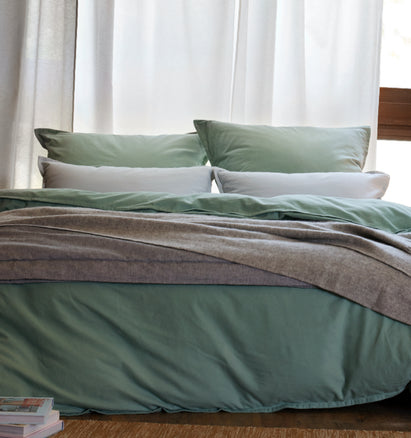Washing bed linen: The best way to do it
On average, we spend about one-third of our lives in bed. Bed linen is a huge factor in how comfortable that time is. Whether it's made of light linen, cosy cotton or fine satin - your bedding is a significant component in catching those all-important Z's. But what temperature is best for washing bed linen? How often should we do it? And on which programme? There are just so many programmes.
In this article, you will learn the best way to clean your bed linen.
How to wash bed linen: The first steps...
It is best to turn sheets, duvet covers, and pillowcases inside out, protecting the fabric, colours and prints. You should also, if possible, close all buttons and zips, so nothing gets caught during washing.
Make sure nothing sharp has made it into the washing drum, so you can prevent damaging your bed linen during the cycle.
Bulky objects, such as shoes, should not be placed in the washing machine with the bed linen.
If you've got stubborn stains, it's best to soak the bed linen before washing to achieve a better result.
Also, be sure to observe the maximum machine load. There should always be some space left at the top of the drum.
At what temperature do I wash bed linen?
After all, at 60°C, mites and moulds, which can trigger allergies, finally get too hot. On the other hand, this is not necessary for every wash cycle. In normal circumstances, 40°C is more than enough.
Washing at 40°C protects the fabric and ensures the longest life for your bed linen. Secondly, you save electricity and water - a win-win situation for you and the environment. Be sure to take a look at the care label. Sensitive materials such as silk or wool may often only be washed at 30°C.
How often should I wash bed linen?
For washing, every person has their own requirements. In other words, it depends on how much you sweat and how prone to allergies you are. Since our bed linen comes into contact with moisture every night and creates a climate where mites feel at home, you should wash your bed linen at least once every fortnight. If you sweat a lot, suffer badly with allergies, or even if the temperatures have risen because it is finally summer, it is advisable to throw your bed linen into the machine once a week. This also applies to beds where pets regularly sleep.
Washing bed linen: programme and detergent
It would be best to refer to the label for any care instructions on the washing programme. Generally, a white or boil wash programme is best for white cotton linen, but a coloured programme is best for coloured bed linen. You should select a delicate or gentle wash cycle for soft fabrics such as satin.
When it comes to detergents, the general rule is: use a heavy-duty detergent for white fabrics, a coloured detergent for coloured or printed fabrics and a delicate detergent for delicate fabrics. Material-specific products such as wool or silk detergents are now also available.
Tip: Do not use fabric softeners. They cause the fibres to stick together and reduce the material's absorbency. By the way, laundry washed at low temperatures can also be perfectly cleaned with a hygiene rinser.
The right fabric for a restful night's sleep
Whether it's a pillowcase or duvet cover: the best way to sleep is in the right material. At URBANARA you will find bed linen for every need. Flannel is perfect for a warm and cosy night, for example. Then, when it's hotter, breathable bed linen made of percale or linen might be a better choice. Looking for an easy-care all-rounder? Then you shouldn't miss out on our high-quality jersey bed linen. If you suffer from allergies, Renforcé bed linen is the best choice. Visit our online shop and discover exactly the right fabric for your needs.
Some more tips...
Spinning the bed linen after washing is generally not a problem. Here, too, the care label often helps to determine the maximum number of revolutions per minute. As a rule, robust materials may be spun at up to 1,400 revolutions, sensitive ones at 600 to 800.
It is also important that the bedding is completely dry before use. This way you avoid unpleasant odours and uninvited microscopic guests.
If you have winter and summer bed linen, the respective bed linen should always be stored in an airtight container out of season to protect it from moths and mould.





